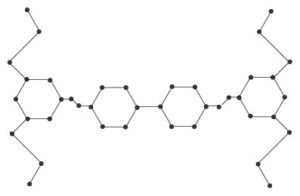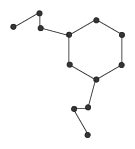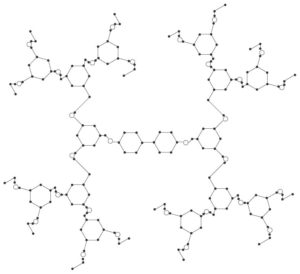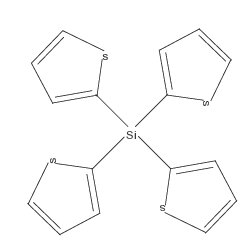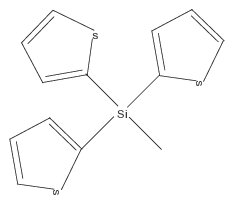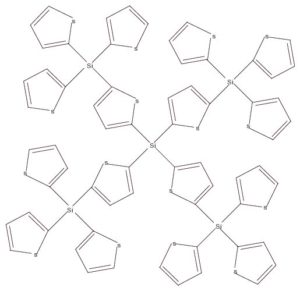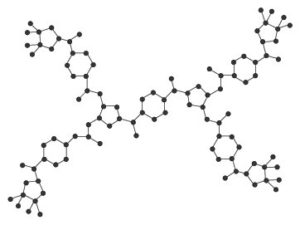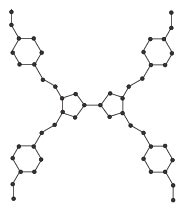Open Journal of Mathematical Sciences
ISSN: 2523-0212 (Online) 2616-4906 (Print)
DOI: 10.30538/oms2019.0083
On chromatic polynomial of certain families of dendrimer graphs
Centre of Advance Studies in Pure and Applied Mathematics, Bahauddin Zakariya University, Multan, Pakistan.; (A.S & S.A.U.H.B)
\(^{1}\)Corresponding Author: sihtsham@gmail.com
Abstract
Keywords:
1. Introduction
A simple graph \(G=(V, E)\) is a finite nonempty set \(V(G)\) of objects known as vertices together with a set \(E(G)\) of unordered pairs of distinct vertices of \(G\) known as edges. The \(\textit{t-coloring}\) of a graph \(G\) is a function \(g : V (G)\rightarrow\{1,2,...t\}\) which satisfies \(g(u)\neq\) \(g(v)\) for any edge \(e = (uv)\). In 1912, Birkhoff [1], presented the concept of \textit{chromatic} \textit{polynomial} to solve the four color problem. More precisely, a graph \(G\) is said to be \textit{t}-colorable if such \(t\)-coloring exists and we say \(G\) is \(\textit{t}\)- colorable. The \textit{chromatic} \textit{number} \(\chi (G)\) is the minimal \(t\) for which the graph is \textit{t}-colorable, and we say that \(G\) is \textit{t}-chromatic if \(\chi (G) = t\).
The chromatic polynomial is defined as the number of distinct \(t\)-colorings in a graph \(G\) and is denoted by the \(P(G,t)\). If the two graphs \(G\) and \(H\) have the same chromatic polynomial then the graphs defined as the chromatically equivalent graphs. In recent years, the fields of cheminformatics, physics, computer sciences and other social sciences have attracted their attention for research prospects in graph theory. A lot of research has been done by using concepts of graph theory in these fields. In molecular graphs, the vertices of the graph represent the atoms of the molecule, and the edges represent the chemical bonds.
Dendrimers are hyper-branched macromolecules, with a rigorously tailored architecture. They can be synthesized, in a controlled manner, either by a divergent or a convergent procedure. Dendrimers have gained a wide range of applications in supramolecular chemistry, particularly in host guest reactions and self-assembly processes. Their applications in chemistry, biology and nanoscience are unlimited. Currently, Alikhani et al. in [2] investigated the mathematical properties of the nanostructures and some of their chromatic polynomials. In this paper, we have investigated the chromatic polynomials of certain dendrimers nanostars.
2. Known Results
In this section, we present some known result about chromatic polynomials of dendrimer graphs.Theorem 1. [3] Fundamental Reduction Theorem. $$P(G,t)=P(G-e,t)-P(G/e,t).$$
Suppose that \(G\) is a simple graph which has an edge \(e\). Then \(G-e\) is a graph obtained from the graph \(G\) by eliminating an edge \(e\) and \(G/e\) is a graph obtained from the graph \(G\) by contracting an edge \(e\) to one vertex. Let \(P_{m+1}\) be a path with vertices \(y_{o},y_{1},y_{2},...,y_{m}\) and \(G\) be any graph. The graph \(G_{v_{o}}(m)=G(m)\) is a graph obtained from \(G\) by identifying a vertex \(v_{o}\) of \(G\) with an end vertex \(y_{o}\) of \(P_{m+1}\), see Figure 1. For example, if \(G\) is a path \(P_{2}\), then \(G(m)=P_{2}(m)\) is the path \(P_{m+2}\).Figure 1. The Graphs \(G(m)\) and \(G_{1}(m)G_{2}\)]{The Graphs \(G(m)\) and \(G_{1}(m)G_{2}\)
Theorem 2. [4] If the graphs \(G\) and \(H\) have only one common vertex, such that \(V (G)\cup V (H) = { \nu }\), we have $$P(G \cup H,t) =\frac{P(G, t)P(H, t)}{t}.$$
Lemma 3. [5] Let \(G\) be a graph of order \(n\) and size \(m\) and \({P}(G,t)\) be the chromatic polynomial of \(G\), then
- a) \(deg({P}(G,t)=n\),
- b) the coefficient of \(t^n\) is \(1\),
- c) the coefficient of \(t^{n-1}\) is \(-m\).
3. Main Results
3.1. Chromatic polynomial of Polyaryl Ether dendrimer
Polyaryl ether dendrimer is an important class of commercial polymers. The \(32\) carboxylate groups on dendrimers surface makes it highly soluble in basic aqueous solution, its three dimensional structure is constructed in possessing a central unit or core unit denoted by \(G_{1}(0)\) (see Figure 2). Its branches, also known as added branches which are denoted by the graph \(H\) (see Figure 3) and the end groups which overall has grown to \(n\) number of stages. The graph can be divided into \(4^n\) hexagonal in each step. The graph of polyaryl ether dendrimer is denoted by \(G_{1}(n)\) and shown in the Figure 4.Figure 2. The graph of polyaryl ether dendrimer nanostar]{The graph of polyaryl ether dendrimer nanostar \(G_{1}(0)\)
Figure 3. The graph of polyaryl ether dendrimer nanostar]{The graph of added branch of polyaryl ether dendrimer nanostar denoted by \(H\).
Figure 4. The graph of polyaryl ether dendrimer]{The graph of polyaryl ether dendrimer \(G_{1}(2)\)
Theorem 4. The chromatic polynomial of the polyaryl ether dendrimer \(G_{1}(0)\) is $${P}(G_{1}(0),t)=t(t-1)^23(t^4-5t^3+10t^2-10t+5)^4.$$
Proof. By applying Theorem 2 and Equation (1), we get $${P}(G_{1}(0),t)=\frac{(t-1)^{19}({P}(C_{6},t))^4}{t^3}=t(t-1)^{23}(t^4-5t^3+10t^2-10t+5)^4.$$
Theorem 5. For \(n \geq 0 \), the chromatic polynomial of \(G_{1}(n)\) is as: $${P}(G_{1}(n),t)=t(t-1)^{28.2^n-5}(t^4-5t^3+10t^2-10t+5)2^{n+2}.$$
Proof. The proof is constructed by induction on \(n\). Since result is true for \(n=0\) by Theorem 4. Let us suppose that the result is true for any values less than \(n\) and we prove it for \(n\). The chromatic polynomial of core of polyaryl ether dendrimer graph is $${P}(G_{1}(0),t)=t(t-1)^{23}(t^4-5t^3+10t^2-10t+5)^4.$$ The chromatic polynomial of the graph \(H\) is computed by applying Theorem 2 and Equation (1). $${P}(H,t)=(t-1)^6{P}(C_{6},t)={P}(H,t)=t(t-1)^7(t^4-5t^3+10t^2-10t+5),$$ For \(n \geq 1\), the graph \(G_{1}(n)\) is obtained from \(G_{1}(n-1)\) by adding \(4(2)^{n-1}\) copies of the graph \(H\) such that each copy of the graph \(H\) has vertex in common with the graph \(G_{1}(n-1).\) Therefore by Theorem 2 we get, $${P}(G_{1}(m),t)=\frac{P(G_{1}(m-1),t)\times({P}(H,t))^{4(2^{m-1})}}{t^{4(2^{m-1})}},\,\,\,\,\,\,\,\,1\leq m\leq n.$$ Now by using the backward substitution, we get \begin{eqnarray*}{P}(G_{1}(n),t)&=&\frac{{P}(G_{1}(0),t)\times({P}(H,t))^{4(2^{n}-1))}}{t^{4(2^{n}-1)}}\\ &=&\frac{t(t-1)^{23}(t^4-5t^3+10t^2-10t+5)^4(t(t-1)^7(t^4-5t^3+10t^2-10t+5))^{4(2^n-1)}}{t^{4(2^n-1)}}.\end{eqnarray*} Hence we conclude that $${P}(G_{1}(n),t)=t(t-1)^{28(2^n)-5}(t^4-5t^3+10t^2-10t+5)^{2^{n+2}}.$$
The following result presents the formula for order and size of the Polyaryl ether dendrimer nanostar \(G_{1}(n)\).Corollary 6. Let \(G_{1}(n)\) be the polyaryl ether dendrimer nanostar. Then
- a) \(|V(G_{1}(n)|=44(2^n)-4,\)
- b) \(|EG_{1}(n)|=48(2^n)-5.\)
Proof. a) Using Lemma 3(a), \(deg({P}(G,t))=|V(G)|\) which states that the degree of the chromatic polynomials is equal to the number of vertices in that graph. Since, \(deg({P}(G_{1}(n),t))=44(2^n)-4\) therefore by the Theorem \ref{1bcc}, we get $$|V(G_{1}(n)|=44(2^n)-4.$$ b) Using Lemma 3(c), the coefficient of \(-t^{|V(G)-1|}\) is equal with the number of edges of \(G\). So, Theorem \ref{1bcc} implies that $$|E(G_{1}(n)|=48(2^n)-5.$$
3.2. Chromatic polynomial of Organosilicon dendrimer
The organosilicon dendrimers was first studied and prepared by Nakayama and Lin. Organosilicon dendrimer graph denoted by \(G[n]\) which is different by its construction consisting of three major parts, the core unit denoted by \(G[1]\) (Figure 5), added branches which is denoted by the graph \(H\) and the end groups which overall has grown to \(n\) stages. Let \(H_{1}\) is the graph obtained by vertex gluing of \(C_{5}\) and \(K_{2}.\) The graph \(H\) is obtained by vertex gluing of \(3\) copies of \(H_{1}\) and path \(P_{2}.\) The graph can be divided into \(6(3^{n-1})-2\) pentagons in each stage. The graph \(H\) and \(G[2]\) is shown in Figures 6 and 7.Figure 5. The graph of organosilicon dendrimer \(G[1]\)
Figure 6. The graph of added branch of organosilicon dendrimer \(H\)
Figure 7. The graph of organosilicon dendrimer \(G[2]\)
Theorem 7. The chromatic polynomial of Organosilicon dendrimer \(G[1]\) is $${P}(G[1],t)=t(t-1)^8(t^3-4t^2+6t-4)^4.$$ .
Proof. By applying Theorem 2, we get $${P}(H_{1},t)=\frac{{P}(C_5,t){P}(K_2,t)}{t}=(t-1)((t-1)^5-(t-1))=t(t-1)^2(t^3-4t^2+6t-4).$$ Since, the graph \(G[1]\) is composed of \(4\) copies of the graph \(H_{1}\) such that each copy of the \(H_{1}\) intersect at the common vertex \(t\), where \(t=Si\) from Figure 5. Therefore, from Theorem 2, we have $${P}(G[1],t)=\frac{{P}(H_1,t){P}(H_1,t){P}(H_1,t){P}(H_1,t)}{t.t.t}=\frac{t^4(t-1)^8(t^3-4t^2+6t-4)^4}{t^3},$$ This implies that, $${P}(G[1],t)=t(t-1)^8(t^3-4t^2+6t-4)^4.$$
Theorem 8. For \(n \geq 1\), the chromatic polynomial of \(G[n]\) is $${P}(G[n],t)=t(t-1)^{14(3^{n-1})-6}(t^3-4t^2+6t-4)^{6(3^{n-1})-2}.$$
Proof. The proof is constructed by induction on \(n\). Since the result is true for \(n=1\) by Theorem 7. Let us suppose that the result is true for any values less than \(n\) and we prove it for \(n\). The chromatic polynomial of organosilicon dendrimer for \(G[1]\) is, $${P}(G[1],t)=t(t-1)^8(t^3-4t^2+6t-4)^4.$$ The chromatic polynomial of Organosilicon dendrimer for the graph \(H\) can be computed by applying Theorem 2 and Equation (1), as follows $${P}(H,t)=\frac{(t-1)^4({P}(C_{5},t))^3}{t^2}=t(t-1)^7(t^3-4t^2+6t-4)^3.$$ For \(n \geq 2\), the graph \(G[n]\) is obtained from \(G[n-1]\) by adding \(4(3)^{n-2}\) copies of the graph H such that each copy of the graph \(H\) has vertex in common with the graph \(G[n-1].\) Therefore by Theorem 2, we get $${P}(G[m],t)=\frac{{P}(G[m-1],t)\times({P}(H,t))^{4(3^{m-2})}}{t^{4{(3^{m-2})}}},\,\,\,\,\,\,\,\,\, 2\leq m\leq n.$$ Now by using the backward substitution, we get \begin{eqnarray*}{P}(G[n],t)&=&\frac{{P}(G[1],t)\times({P}(H,t))^{2{(3^{n-1}-1))}}}{t^{2(3^{n-1}-1)}}\\ &=&t(t-1)^8(t^3-4t^2+6t-4)^4((t-1)^7(t^3-4t^2+6t-4))^{2(3^{n-1}-1)}\\ &=&t(t-1)^{14(3^{n-1})-6}(t^3-4t^2+6t-4)^{6\times3^{n-1}-2}.\end{eqnarray*}
The following result presents the formula for order and size of the Organosilicon dendrimer \(G[n]\).Corollary 9. For the Organosilicon dendrimer \(G[n]\), we have
- a) \(|V(G[n])|=21+32[3^{n-1}-1],\)
- b) \(|E(G[n])|=24+38[3^{n-1}-1].\)
Proof. a) Using Lemma 3(a), \(deg({P}(G,t))=|V(G)|\) which states that the degree of the chromatic polynomial is equal to the number of vertices in that graph. Since, \(deg({P}(G,t))=21+32[3^{n-1}-1]\), therefore Theorem 8 implies that $$|V(G[n])|=21+32[3^{n-1}-1].$$ b) Using Lemma 3(c), the coefficient of \(-t^{|V(G)-1|}\) is equal with the number of edges of \(G\). So Theorem 8 implies that $$|E(G[n])=24+38[3^{n-1}-1].$$
3.3. Chromatic polynomial of Nanostar dendrimer
For \( n\geq 1\), the graph of Nanostar dendrimer \(NSC_{5}C_{6}\) denoted by \(G_{2}(n)\) which is different by its construction consisting of major parts core unit, added branches and end groups, which overall has grown to \(n\) stages. First stage consists of a hexagon with two pentagons and for \( n\geq 2\) the new branches \(4(2^{n-2})\) emitting from the very first stage are added and their step wise growth follows a structure of Nanostar dendrimer \(NSC_{5}C_{6}\). The graph of \(G_{2}(2)\) and the graph of added branch denoted by \(H\) is shown in Figures 8 and 9 respectively. Now, we will determine the chromatic polynomial of family of dendrimer nanostar \(NSC_{5}C_{6}\) denoted by \(G_{2}(n).\)Figure 8. The graph \(G_{2}(2)\) of dendrimer nanostar \(NSC_{5}C_{6}\)
Figure 9. The graph \(H\) of added branch of dendrimer nanostar \(NSC_{5}C_{6}\)
Theorem 10. The chromatic polynomial of Nanostar dendrimer \(NSC_{5}C_{6}\) denoted by \(G_{2}(1)\) is: $${P}(G_{2} (1),t)=t(t-1)^{17}(t^3-4t^2+6t-4)^2(t^4-5t^3+10t^2-10t+5).$$
Proof. By applying Theorem 2 and Equation (1), we get $${P}(G_{2}(1),t)=\frac{(t-1)^{14}{P}(C_6,t)({P}(C_5,t))^2}{t^2}=t(t-1)^{17}(t^3-4t^2+6t-4)^2(t^4-5t^3+10t^2-10t+5).$$
Theorem 11. For \(n \geq 0\), the chromatic polynomial of \(G_{2}(n)\) is: $${P}(G_{2}(n),t)=t(t-1)^{11(2^{n+1})-27}(t^3-4t^2+6t-4)^{2^{n+1}-2}(t^4-5t^3+10t^2-10t+5)^{2^{n+1}-3}.$$
Proof. The proof is constructed by induction on \(n\). Since the result is true for \(n=1\) by Theorem 10. Let us suppose that the result is true for any values less than \(n\) and we prove it for \(n\). The chromatic polynomial of \(G_{2}(1)\) is $${P}(G_{2}(1),t)=t(t-1)^{17}(t^3-4t^2+6t-4)^2(t^4-5t^3+10t^2-10t+5).$$ The chromatic polynomial for the graph \(H\) can be calculated by applying Theorem 2 and Equation (1), we get $${P}(H,t)=\frac{(t-1)^9{P}(C_{5},t){P}(C_{6},t)}{t}=t(t-1)^{11}(t^3-4t^2+6t-4)(t^4-5t^3+10t^2-10t+5).$$ For \(n \geq 2\), the graph \(G_{2}(n)\) is obtained from \(G_{2}(n-1)\) by adding \(4(2)^{n-2}\) copies of the added graph H such that each copy of the graph \(H\) has vertex in common with the graph \(G_{2}(n-1).\) Therefore by Theorem 2, we get $${P}(G_{2}(m),t)=\frac{{P}(G_{2}(m-1),t)\times({P}(H,t))^{4(2^{m-2})}}{t^{4(2^{m-2})}},\,\,\,\,\,\,2\leq m\leq n.$$ Now by using the backward substitution, we get \begin{eqnarray*}{P}(G_{2}(n),t)&=&\frac{{P}(G_{2}(1),t)\times({P}(H,t))^{4(2^{n-1}-1))}}{t^{4(2^{n-1}-1)}}\\ &=&t(t-1)^{17}(t^3-4t^2+6t-4)^2(t^4-5t^3+10t^2-10t+5)\\ &&\times[(t-1)^{11}(t^3-4t^2+6t-4)(t^4-5t^3+10t^2-10t+5)]^{4(2^{n-1}-1)}.\end{eqnarray*} Hence we conclude that $${P}(G_{2}(n),t)=t(t-1)^{11(2^{n+1})-27}(t^3-4t^2+6t-4)^{2^{n+1}-2}(t^4-5t^3+10t^2-10t+5)^{2^{n+1}-3}.$$
The following result presents the formula for order and size of the Nanostar dendrimer.Corollary 12, Let \(G_{2}(n)\) be the Nanostar dendrimer \(NSC_{5}C_{6}\). Then we have
- a) \(|V(G_{2}(n))|=9\times2^{n+2}-44,\)
- b) \(|E(G_{2}(n))|=9\times2^{n+2}-45.\)
Proof. a) Using Lemma 3(a), \(deg({P}(G,t))=|V(G)|\) which states that the degree of the chromatic polynomial is equal to the number of vertices in that graph. Since, \(deg({P}(G_{2}(n),t))=9\times2^{n+2}-44,\) therefore Theorem 11 implies that, $$|V(G_{2}(n),t)|=9\times2^{n+2}-44.$$ b) Using Lemma 3 (c), the coefficient of \(-t^{|V(G)-1|}\) is equal with the number of edges of \(G\). So Theorem 11 implies that $$|E(G_{2}(n),t)|=9\times2^{n+2}-45.$$
3.4. Chromatic polynomial of Tetrathiafulvalence dendrimer
The graph of Tetrathiafulvalence dendrimer simply denoted by \(TD_{2}[n]\) consisting of core unit, added branches and end groups which has overall grown to \(n\) stages and each stage consists of \(2^{n+3}-6\) pentagons with \(2^{n+3}-4\) hexagons. After the core unit stage, for \(n\geq 1\), \(4(2^{n-1})\) branches are added to every stage of the graph and hence, their stepwise growth follows a structure of the tetrathiafulvalence dendrimer, \(TD_{2}[n]\). The graph of \(TD_{2}[0]\) is the core of graph, the graph of added branch \(H\) and the graph of \(TD_{2}[1]\) is shown in Figure 10, 11 and 12. Now, we will determined the chromatic polynomial of class of dendrimer known as tetrathiafulvalence dendrimer \(TD_{2}[n].\)Figure 10. The core of tetrathiafulvalence dendrimer \(TD_{2}[0]\).
Figure 11. The added graph \(H\) in each branch of \(TD_{2}[n]\).
Figure 12. The graph of Tetrathiafulvalence dendrimer, \(TD_{2}[1]\).
Theorem 13. The chromatic polynomial of tetrathiafulvalence dendrimer \(TD_{2}[0]\) is: $${P}(TD_{2}[0]),t )=t(t-1)^{27}(t^3-4t^2+6t-4)^2(t^4-5t^3+10t^2-10t+5)^4.$$
Proof. By applying Theorem 2 and Equation (1), we get $${P}(TD_{2}[0],t)=\frac{(t-1)^{21}({P}(C_6,t))^4({P}(C_5,t))^2}{t^5}.$$ This implies that $${P}(TD_{2}[0],t))=t(t-1)^{27}(t^3-4t^2+6t-4)^2(t^4-5t^3+10t^2-10t+5)^4.$$
Theorem 14. For \(n \geq 0\), the chromatic polynomial of \(TD_{2}[n]\) is: $${P}(TD_{2}[n],t)=t(t-1)^{17(2^{n+2})-41}(t^3-4t^2+6t-4)^{2^{n+3}-6}(t^4-5t^3+10t^2-10t+5)^{2^{n+3}-4}.$$
Proof. The proof is constructed by induction on \(n\). Since the result is true for \(n=0\) by Theorem 13. Let us suppose that the result is true for any values less than \(n\) and we prove it for \(n\). The chromatic polynomial of the graph \(TD_{2}[n]\) is $${P}(TD_{2}[0],t)=t(t-1)^{27}(t^3-4t^2+6t-4)^2(t^4-5t^3+10t^2-10t+5)^4.$$ The chromatic polynomial for graph \(H\) can be calculated by applying Theorem 2 and Equation (1), as follows: $${P}(H,t)=\frac{(t-1)^{13}({P}(C_6,t))^2({P}(C_5,t))^2}{t^3}=t(t-1)^{17}(t^3-4t^2+6t-4)^2(t^4-5t^3+10t^2-10t+5)^2.$$ For \(n \geq 1\), the graph \(TD_{2}[n]\) is obtained from \(TD_{2}[n-1]\) by adding \(4(2)^{n-1}\) copies of the graph \(H\) such that each copy of the graph \(H\) has vertex in common with the graph \(TD_{2}[n-1].\) Therefore by Theorem 2, we have $${P}(TD_{2}[m],t)=\frac{{P}(TD_{2}[m-1],t)\times({P}(H,t))^{4(2^{m-1})}}{t^{4(2^{m-1})}},\,\,\,\,\,1\leq m\leq n.$$ Now by using the backward substitution, we get \begin{eqnarray*}{P} (TD_{2}[n],t)&=&\frac{{P}(TD_{2}[0],t)\times({P}(H,t))^{4(2^{n}-1)}}{t^{4(2^{n}-1)}}\\ &=&\frac{t(t-1)^{27}(t^3-4t^2+6t-4)^2(t^4-5t^3+10t^2-10t+5)^4}{t^{4(2^{n-1})}}\\ &&\times\frac{[t(t-1)^{17}(t^3-4t^2+6t-4)^2(t^4-5t^3+10t^2-10t+5)^2]^{4(2^{n-1})}}{t^{4(2^{n-1})}}.\end{eqnarray*} Hence we conclude that $${P}(TD_{2}[n]),t)=t(t-1)^{17(2^{n+2})-41}(t^3-4t^2+6t-4)^{2^{n+3}-6}(t^4-5t^3+10t^2-10t+5)^{2^{n+3}-4}.$$
The following result presents the formula for size and order of Tetrathiafulvalence dendrimer.Corollary 15. For the Tetrathiafulvalence dendrimer \(TD_{2}[n]\), we have
- a) \(|V(TD_{2}[n])|=50+124(2^{n}-1),\)
- b) \(|E(TD_{2}[n])|=5(28(2^n)-17).\)
Proof. a) Using Lemma 3(a), \(deg({P}(G,t))=|V(G)|\) which states that the degree of the chromatic polynomial is equal to the number of vertices in that graph. Since, \(deg({P}(TD_{2}[n],t))=50+124(2^{n}-1),\) therefore Theorem 14 implies that $$|V(TD_{2}[n],t)|=50+124(2^{n}-1).$$ b) Using Lemma 3(c), the coefficient of \(-t^{|V(G)-1|}\) is equal with the number of edges of \(G\). So Theorem 14 implies that $$|E(TD_{2}[n],t)|=5(28(2^n)-17).$$
3.5. Chromatic polynomial of Polyther nanostar dendrimer
The graph of polyther dendrimer \(PD_{3}[n]\) consisting of core unit, added branches and end groups which has overall grown to the \(n\) stages and each stage consists of \(3(2^{n+1}-1)\) hexagons. The new branches \(3(2^{n}-1)\) emitting from the very first stage are added and their step wise growth follows a structure of polyther dendrimer nanostar \(PD_{3}[n]\). The core of polyther dendrimer \(PD_{3}[0]\) and the graph of \(PD_{3}[1]\) and the graph of added branch \(H\) is shown in Figure 13, 14 and 15.Figure 13. The core of polyther dendrimer \(PD_{3}[0]\).
Figure 14. The graph of \(H\) of polyther dendrimer \(PD_{3}[n]\).
Figure 15. The graph of polyther dendrimer \(PD_{3}[1]\).
Theorem 16. The chromatic polynomial of polyther dendrimer nanostar \(PD_{3}[0]\) is $${P}(PD_{3}[0],t)=t(t-1)^{10}(t^4-5t^3+10t^2-10t+5)^3.$$
Proof. By applying Theorem 2 and Equation (1), we get $${P}(PD_{3}[0],t)=\frac{(t-1)^7({P}(C_6,t))^{3}}{t^2}.$$ This implies that $${P}(PD_{3}[0],t)=t(t-1)^{10}(t^4-5t^3+10t^2-10t+5)^3.$$
Theorem 17. For \(n \geq 0\), the chromatic polynomial of \(PD_{3}[n]\) is: $${P}(PD_{3}[n],t)=t(t-1)^{33(2^n)-23}(t^4-5t^3+10t^2-10t+5)^{3(2^{n+1})-3}.$$
Proof. The proof is constructed by induction on \(n\). Since the result is true for \(n=0\) by Theorem 16. Let us suppose that the result is true for any values less than \(n\) and we prove it for \(n\). The chromatic polynomial of polyther dendrimer for \(PD_{3}[1]\) is $${P}(PD_{3}[0],t)=t(t-1)^{10}(t^4-5t^3+10t^2-10t+5)^3.$$ The chromatic polynomial for the graph \(H\) can be calculated by applying Theorem 2 and Equation (1), we get $${P}(H,t)=\frac{(t-1)^{9}({P}(C_6,t))^2}{t}=t(t-1)^{11}(t^4-5t^3+10t^2-10t+5)^{2}.$$ For \(n \geq 1\), the graph \(PD_{3}[n]\) is obtained from \(PD_{3}[n-1]\) by adding \(3(2)^{n-1}\) copies of the added graph H such that each copy of the graph \(H\) has vertex in common with the graph \(PD_{3}[n-1].\) Therefore by Theorem 2, we get $${P}(PD_{3}[m],t)=\frac{{P}(PD_{3}[m-1],t)\times({P}(H,t))^{3(2^{m-1})}}{t^{3(2^{m-1})}},\,\,\,\,\,1\leq m\leq n.$$ Now by using the backward substitution, we get $${P}(PD_{3}[n],t)=t(t-1)^{10}(t^4-5t^3+10t^2-10t+5)^3)[\frac{(t(t-1)^{11}(t^4-5t^3+10t^2-10t+5)^{2})^{3(2^n-1)}}{t^{3(2^n-1)}}].$$ Hence we conclude that $${P}(PD_{3}[n],t)=t(t-1)^{33(2^n)-23}(t^4-5t^3+10t^2-10t+5)^{3(2^{n+1})-3}.$$
The following result presents the formula for order and size of the polyther dendrimer \(PD_{3}[n]\).Corollary 18. For the Polyther dendrimer \(PD_{3}[n]\), we have
- a) \(|V(PD_{3}[n])|=57(2^n)-34,\)
- b) \(|E(PD_{3}[n])|=63(2^n)-38.\)
Proof. a) Using Lemma 3(a), \(deg({P}(G,t))=|V(G)|,\) which states that the degree of the chromatic polynomial is equal to the number of vertices in that graph. Since, \(deg({P}(PD_{3}[n],t))=57(2^n)-34,\) therefore Theorem 17 implies that $$|V(PD_{3}[n])|=57(2^n)-34.$$ b) Using Lemma 3(c), the coefficient of \(-t^{|V(G)-1|}\) is equal with the number of edges of \(G\). So Theorem 17 implies that $$|E(PD_{3}[n])=63(2^n)-38.$$
4. Conclusion
Dendrimers have wide range of applications in supra-molecular chemistry, particularly in host guest reactions and self-assembly processes. During the past several years, there are many research papers dealing with the study of mathematical and topological properties of certain dendrimer nano-structures in [6, 7, 8, 9, 10]. Currently, Alikhani and Iranmanesh investigated the mathematical properties of the nanostructures and some of their chromatic polynomials [2]. In this paper, we have extended this study and computed the chromatic polynomials of certain dendrimers.Author Contributions
All authors contributed equally to the writing of this paper. All authors read and approved the final manuscript.Competing Interests
The author(s) do not have any competing interests in the manuscript.References
- Birkhoff, G. D. (1912). A determinant formula for the number of ways of coloring a map. The Annals of Mathematics, 14(1/4), 42-46. [Google Scholor]
- Alikhani, S., & Iranmanesh, M. A. (2010). Chromatic polynomials of some dendrimers. Journal of Computational and Theoretical Nanoscience, 7(11), 2314-2316. [Google Scholor]
- Fengming, D., & Khee-meng, K. (2005). Chromatic polynomials and chromaticity of graphs. World Scientific. [Google Scholor]
- Zykov, A. A. (1949). On some properties of linear complexes. Matematicheskii sbornik, 66(2), 163-188. [Google Scholor]
- Farrell, E. J. (1980). On chromatic coefficients. Discrete Mathematics, 29(3), 257-264. [Google Scholor]
- Gutman, I., & Polansky, O. E. (2012). Mathematical concepts in organic chemistry. Springer-Verlag, New York. [Google Scholor]
- Hasni, R., Arif, N. E., & Alikhani, S. (2014). Eccentric Connectivity Polynomials of Some Families of Dendrimers. Journal of Computational and Theoretical Nanoscience, 11(2), 450-453. [Google Scholor]
- Hayat, S., & Imran, M. (2014). Computation of topological indices of certain networks. Applied Mathematics and Computation, 240, 213-228.[Google Scholor]
- Imran, M., Hayat, S., & Shafiq, M. K. (2015). Valency based topological indices of organosilicon dendrimers and cactus chains. Optoelectronics and Advanced Materials-Rapid Communications, 9(May-June 2015), 821-830. [Google Scholor]
- Khalifeh, M. H., Yousefi-Azari, H., & Ashrafi, A. R. (2009). The Szeged and Wiener Numbers of Water-Soluble Polyaryl Ether Dendrimer Nanostars. Digest Journal of Nanomaterials & Biostructures (DJNB), 4(1), 63-66. [Google Scholor]


